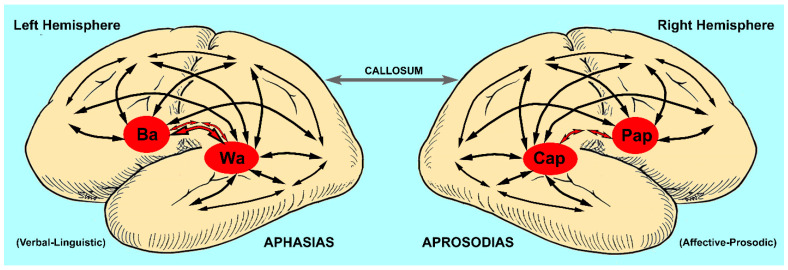Figure 1.
Cortical map for the neuroanatomical basis of language (Ba = Broca’s area or motor speech center, Wa = Wernicke’s area or acoustic speech center, Cap = comprehension of affective prosody or acoustic affect center, Pap = production of affective prosody or motor affect center, red-filled arrows = arcuate fasciculus). Note that the arcuate fasciculus is anatomically different for each hemisphere. The left arcuate fasciculus is composed of a direct bundle and an indirect bundle that synapses in the inferior parietal lobe, whereas the right arcuate fasciculus is composed mainly of an indirect bundle that synapses in the inferior parietal lobe with a mostly vestigial direct bundle [29,30]. Comprehension and production of language is accomplished through various distributed parallel neural networks with Broca’s and Wernicke’s areas and their analogs in the right hemisphere (Pap, Cap), serving as nodal points in conjunction with modality specific (unimodal) and higher-order (heteromodal) associational regions of the neocortex (multiple black arrows) [31]. Lesions that injure the peri-Sylvian (opercula) cortex cause aphasias and aprosodias that have, in common, loss of repetition (motor, sensory, conduction and global syndromes). Lesions that injure the para-Sylvian associational regions of the neocortex cause aphasias and aprosodias that have, in common, preservation of repetition (transcortical motor, transcortical sensory, mixed transcortical and anomic or agesic syndromes) [15]. The frontal motor-related language regions of each hemisphere interact via the anterior corpus callosum to pre-condition each other before each hemisphere generates its motor outputs to the brainstem for the production of articulate speech to ensure that the verbal–linguistic and affective prosodic components are temporally and behaviorally coherent (see Section 2.4, fourth and last paragraphs) [32,33]. Not included in the map are subcortical structures that are part of an expanded neural network underlying language [15].

